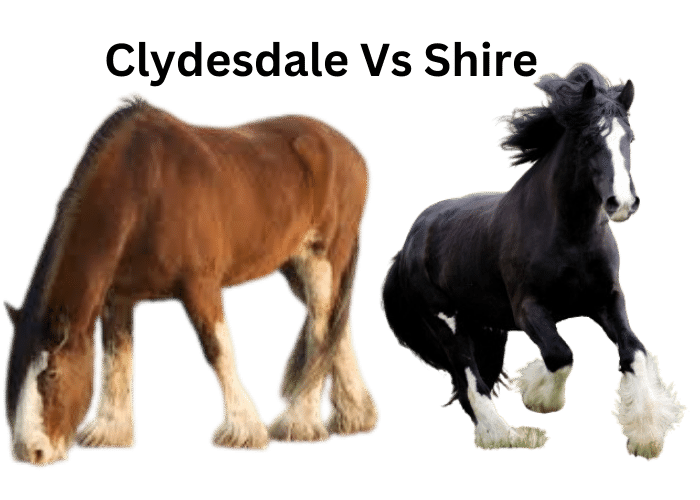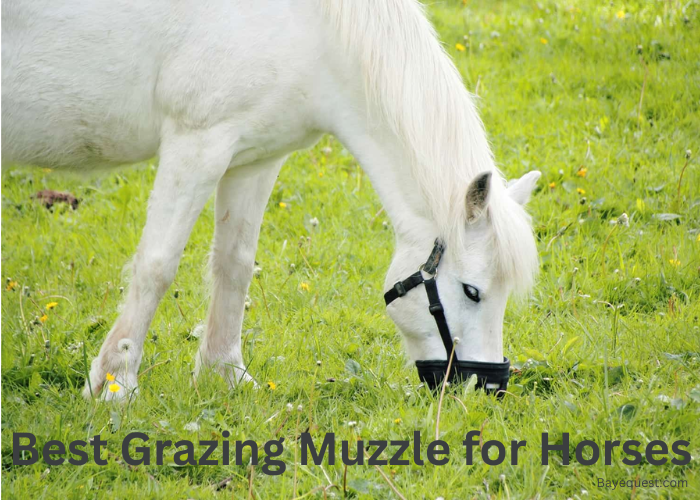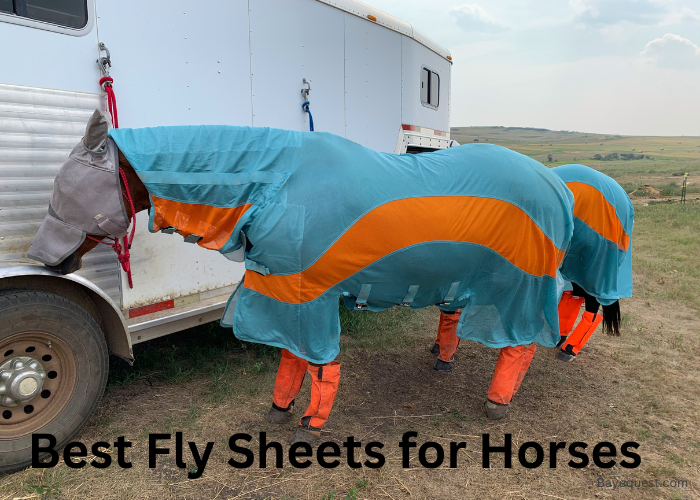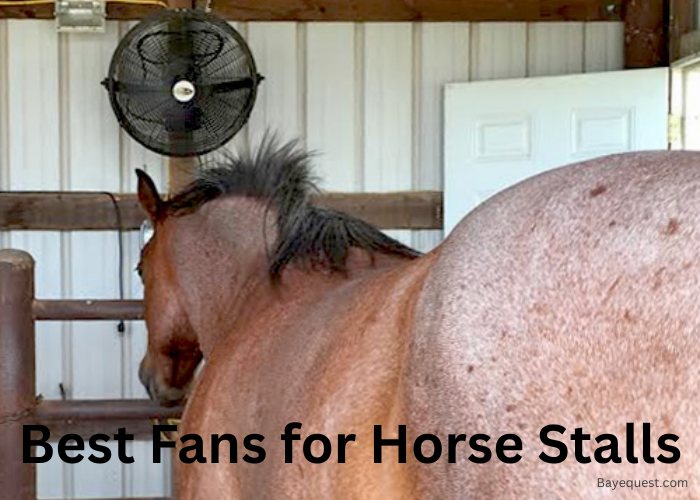Did you know the Clydesdale and Shire horses, two of the largest and strongest breeds, differ in more than just size? Understanding these differences can be crucial when choosing the right breed.
In this article, we’ll explore the key distinctions between these gentle giants, helping you make an informed decision. Whether you’re a horse enthusiast or just curious, we’ll break down what sets these breeds apart and what that means for you.
Let’s dive into the details.
Clydesdale Vs Shire Horse: Key Takeaway
Clydesdales are known for their tall stature, flashy appearance, and friendly demeanor. They originated in Scotland and excel in various activities, from farm work to parades. Shires, on the other hand, are even larger and more powerful, originating from England. They possess a calm and steady temperament, ideal for heavy draft work.
About Clydesdale Horses
Let’s chat about Clydesdales, those gentle giants with the big hearts and even bigger footsteps. Born in Scotland, they’re like the strong, silent types of the horse world.
They are so tall that you might need a ladder just to whisper in its ear. Cloaked in a coat that can be black, bay, or rosy brown, they often sport flashy white markings that look like nature’s own artwork.
Their most distinctive feature? Feathered legs. It’s like they’re wearing their own fancy, fluffy boots, ready to step out in style, rain or shine.
Clydesdales are the kind of friends you’d want on your team, whether you’re pulling a heavy load or just need a steady companion to brighten your day. They’re strong, sure, but it’s their gentle nature and willingness to work that truly set them apart.
So, whether it’s strutting their stuff in a parade or working quietly in a field, Clydesdales have a way of capturing hearts. With each trot, they seem to say, “Take it easy, but take it strong.” And that’s the kind of advice we could all use a bit more of, don’t you think?
About Shire Horses
Now, let’s wander into the world of the Shire horse, the true titans of the equine realm. Hailing from England, these horses are like the gentle giants of a fairy tale, both imposing and kindhearted.
Imagine a creature so grand, its silhouette alone commands attention, draped in a coat that shines in shades of black, gray, bay, or even a deep blue.
Shires have a towering height and muscular build. This makes them look like the knights of the horse world.
However, it’s not just their size that turns heads. It’s their calm, collected demeanor and work ethic that’s as strong as their build.
They also have feathered legs, thick and sturdy, almost like they’re wearing nature’s version of snow boots.
What sets Shires apart is not just their ability to pull weight but their gentle nature. They’re the type of horse that seems to understand the world in a wise and serene way. Whether they’re in the field, pulling a plow, or leading a parade, Shires do it with rare dignity.
In the presence of a Shire, you can’t help but feel a mix of awe and affection. They remind us that true strength is gentle and that the biggest hearts often come in the largest packages.
Clydesdale Vs Shire Horses: In-Depth Comparison
Let’s dive into the world of Clydesdales and Shires in this concise comparison.
Shire Vs Clydesdale Horse: Origin
Clydesdales are Scotland’s pride, originally bred in the Clyde Valley. The Clydesdale was the answer to the misty, rolling hills of Scotland. ,
It’s a breed that emerged in the 18th century from Flemish stallions and local mares. They were the engine of the Scottish farms, pulling plows and carts, a vital part of rural life.
On the flip side, Shire horses tell a different story, one that’s deeply rooted in the English countryside. Tracing their lineage to the Great Horse of medieval England, the Shire was bred for battle and heavy farm work.
By the time of the Industrial Revolution, they had become the powerhouse of England. Their origin speaks of a horse bred for strength and sheer, unstoppable power, a legacy that continues to define them.
So, when we compare their origins, we’re looking at two breeds sculpted by the lands and needs of their people.
Clydesdale Horse Vs Shire: Physical traits
Clydesdales and Shires, they’re both giants but in their own, distinct ways.
When you walk up to a Clydesdale, you see this tall, muscular horse standing proud, usually about 17 to 18 hands high. That’s tall, but it’s their style that really grabs you.
They’ve got these flashy white marks, often on their face and legs, and speaking of legs, don’t forget those feathers. Their coats? Mostly bay, but you might catch them in black, brown, or even roan.
Now, turn your gaze to a Shire. You thought the Clydesdale was tall? Shires take it up a notch, some towering over 18 hands. They’re the bodybuilders of the horse world, built sturdy and strong.
Their coats come in similar shades to Clydesdales, but it’s their sheer size that sets them apart. And those feathers on their legs? Just as striking, making them look both regal and ready for a hard day’s work.
Related read: Clydesdale Average Weight.
Shire and Clydesdale: Characteristics and temperament
Clydesdales are pretty much the life of the barn. Imagine a horse that greets you like a friend, always ready for a chat or a job, whichever comes first.
They’ve got this spirit, you know? It’s like they’re always up for an adventure, whether it’s a parade downtown or a hard day’s work in the field. Clydesdales are the kind of pals who are playful yet know when it’s time to put their shoulder to the wheel.
Now, Shires carry themselves with a kind of noble calm. Think of the wise, old tree in the forest that’s seen it all. Shires have this steadiness to them, a kind of quiet confidence.
They’re strong, yes, but they don’t brag about it. Instead, they show up, day in and day out, reliable as the sunrise. Working with the Shire is like having a wise mentor by your side, one who’s patient and unflappable, no matter what the day throws at you.
Both breeds, with their big hearts and even bigger personalities, show us that strength doesn’t have to shout. It can whisper and still be heard loud and clear.
Shire Horse Vs Clydesdale: Discipline and purpose
When it comes to what Clydesdales and Shires are best at, think of it as their favorite ways to spend a day at work or play.
Clydesdales are like the versatile athletes of the horse world. Originally bred for farm work in Scotland, they’ve got a resume that spans far and wide.
You’ll see them pulling carriages, strutting in parades, and even competing in driving competitions. Their flashy appearance and eager-to-please attitude make them stars in the show ring and beyond.
They also have a knack for connecting with people, which also makes them great for therapeutic riding programs. They’re social butterflies, enjoying the spotlight and the chance to show off their skills.
Shires, with their sheer strength, were the heavy lifters of England. They’re the ones you’d call when you need serious muscle.
But don’t let their workhorse resume fool you; Shires also excel in the show ring, particularly in driving and pulling competitions. They have a more reserved nature, which means they might not crave the spotlight like Clydesdales, but they’re equally as impressive.
Shires Vs Clydesdales: Price
When we talk about the prices of Clydesdales and Shires, there’s a lot depending on what you’re looking for.
If you’re looking to buy a Clydesdale, you might find that prices vary greatly. A Clydesdale horse’s price could be anywhere from a few thousand dollars for a companion animal to tens of thousands for a top show competitor.
What makes the difference? Things like their training, age, pedigree, and how well they strut their stuff in the show ring or work in harness.
The average price for a Shire, on the other hand, can swing in a similar range to that of a Clydesdale. This is usually based on the same factors—breeding, training, age, and potential for work or show.
So, whether you fall for a Clydesdale or a Shire, you could be looking at a similar investment. In the end, the true value isn’t just in the price tag. It’s in the companionship, the work they can do, and the joy they bring.
Clydesdales Vs Shires: Health and care
Taking care of Clydesdales and Shires means giving them lots of love and attention.
For Clydesdales, grooming is key. Those feathered legs look amazing but need regular cleaning to avoid skin issues. They eat a lot, needing hay, grains, and vitamins to stay healthy. Don’t forget the vet for check-ups, hoof care, and teeth cleaning.
Shires need similar care. Their feathers also need attention to keep their legs healthy. With their size, they eat more than most horses. They need space to move and keep fit. Regular vet visits are important for them too.
Both breeds need special care for their legs, good food, and lots of space. Caring for them is a big job but very rewarding. They’re not just big horses; they’re big-hearted friends.
Shire Horses Vs Clydesdale Horses: Lifespan
Regarding how long these gentle giants grace our lives, Shires and Clydesdales have similar lifespans.
Shire horses, those big, beautiful beings, usually live around 20 to 25 years. It’s a good, long life for such large horses, with care and love playing a big part in helping them reach their golden years.
With their distinct charm and feathered legs, Clydesdales also enjoy a lifespan in the ballpark of 20 to 25 years. Like Shires, how long they live can depend a lot on their health care, diet, and how much love we shower them with.
So, whether you’re team Shire or team Clydesdale, these horses can be with you for two or more decades.
Related read: Shire Horse Lifespan and Characteristics.
Comparison Chart: Clydesdale Vs Shire
| Feature | Clydesdale | Shire |
| Origin | Scotland | England |
| Height | 16-18 hands (64-72 inches) | 17-19 hands (68-76 inches) |
| Weight | Around 1,800-2,200 lbs | Approximately 1,800-2,400 lbs |
| Color | Bay, black, brown, and chestnut with significant white markings | Black, bay, brown, and grey, often with white markings |
| Leg feathers | Yes, notable for their extensive feathering | Yes, also features significant feathering but can be heavier |
| Temperament | Friendly, eager to please, and versatile in work and play | Calm, patient, and dependable, with a strong work ethic |
| Uses | Parade and ceremonial duties, agricultural work, riding, and driving | Heavy draft work, agricultural tasks, riding, and driving competitions |
| Lifespan | 20-25 years | 20-25 years |
| Care needs | Regular grooming, especially of leg feathers; ample space and appropriate diet | Similar grooming needs, with attention to leg feathers |
| Price range | $1000 to $20000+ | $2,000 to $20,000 + |
Which One is Better? Shire of Clydesdale?
Choosing between a Shire and a Clydesdale is like picking between two favorite flavors of ice cream. It boils down to what you’re looking for in a horse and your connection with them.
A Shire might be your match if you’re drawn to sheer strength and a calm, steady presence. They’re like the wise old trees of the horse world—strong, dependable, and unshakeably calm.
A Clydesdale could be the way to go if you’re after a horse that’s big and strong, has a bit of sparkle and loves being around people. They’re the life of the party, with a friendly nature and those flashy feathers that catch everyone’s eye.
At the end of the day, both breeds are amazing. They’re big, beautiful, and have hearts just as large as their bodies.
Difference Between Shire and Clydesdale: FAQs
Draft Horses Vs Clydesdales: Which one is better?
The “better” choice between draft horses and Clydesdales depends on the intended use, personal tastes, and what qualities you value in a horse. Clydesdales offer a blend of strength, beauty, and temperament, while other draft breeds might be preferred for specific work tasks or due to breed loyalty.
What is the difference between Clydesdales and regular horses?
The main difference between Clydesdales and regular horses is their size and purpose. Clydesdales are larger and more muscular than most horse breeds. They have distinct feathered legs and gentle temperaments. They were originally bred for heavy draft and farm work, unlike regular horses, which come in various sizes and are bred for various activities.
Difference Between Clydesdale and Shire Horse: Conclusion
Clydesdales and Shires stand tall in the horse world, each with unique traits.
Clydesdales charm with their grace and playful spirit. Shires impress with their strength and serene nature.
The choice between them depends on personal preference. Do you lean towards the Clydesdale’s dynamic presence or the Shire’s steadfast reliability?
Both breeds promise a journey filled with deep connections and awe-inspiring moments.








